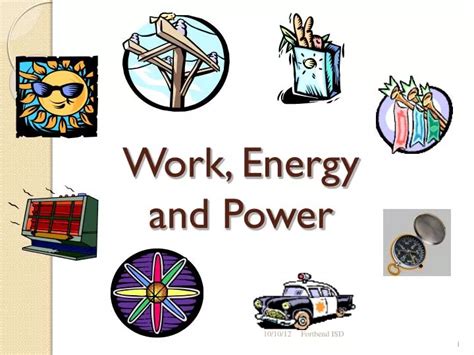Energy, power, and work are fundamental concepts in the realm of physics, and understanding their interrelationships is crucial for grasping the underlying principles of the natural world. In this article, we will delve into the definitions, formulas, and applications of energy, power, and work, exploring how these concepts are intertwined and essential for describing various phenomena in physics and engineering. With a deep understanding of these concepts, we can better appreciate the intricacies of the physical world and develop innovative solutions to real-world problems.
Key Points
- Energy is the capacity to do work, and it comes in various forms, including kinetic, potential, thermal, and electrical energy.
- Power is the rate at which energy is transferred or converted, and it is typically measured in watts (W) or horsepower (hp).
- Work is the transfer of energy from one object to another through a force applied over a distance, and it is measured in joules (J) or foot-pounds (ft-lb).
- The laws of thermodynamics govern the relationships between energy, power, and work, and they have far-reaching implications for fields such as engineering, chemistry, and biology.
- Efficiency is a critical concept in understanding the relationships between energy, power, and work, as it describes the ratio of useful energy output to total energy input.
Energy: The Capacity to Do Work

Energy is a fundamental concept in physics, and it is defined as the capacity to do work. Energy comes in various forms, including kinetic energy (the energy of motion), potential energy (stored energy), thermal energy (the energy of heat), and electrical energy (the energy of charged particles). The SI unit of energy is the joule (J), which is defined as the energy required to apply a force of 1 newton (N) over a distance of 1 meter (m). Energy can be converted from one form to another, but it cannot be created or destroyed, as stated by the law of conservation of energy.
Kinetic Energy and Potential Energy
Kinetic energy is the energy of motion, and it is given by the formula KE = (1⁄2)mv^2, where m is the mass of the object and v is its velocity. Potential energy, on the other hand, is stored energy, and it can be gravitational (e.g., the energy of an object at height), elastic (e.g., the energy of a stretched spring), or electrical (e.g., the energy of a charged capacitor). The formula for potential energy depends on the specific type of energy, but it is generally given by PE = mgh, where m is the mass of the object, g is the acceleration due to gravity, and h is the height of the object.
| Energy Type | Formula | Unit |
|---|---|---|
| Kinetic Energy | KE = (1/2)mv^2 | Joules (J) |
| Potential Energy | PE = mgh | Joules (J) |
| Thermal Energy | Q = mcΔT | Joules (J) |
| Electrical Energy | E = QV | Joules (J) |

Power: The Rate of Energy Transfer

Power is the rate at which energy is transferred or converted, and it is typically measured in watts (W) or horsepower (hp). The formula for power is P = E/t, where E is the energy transferred and t is the time over which the transfer occurs. Power can also be expressed as P = Fv, where F is the force applied and v is the velocity of the object. In electrical systems, power is given by P = VI, where V is the voltage and I is the current.
Efficiency and Power
Efficiency is a critical concept in understanding the relationships between energy, power, and work. Efficiency is defined as the ratio of useful energy output to total energy input, and it is typically expressed as a percentage. The efficiency of a system can be improved by reducing energy losses, such as friction, heat, or electrical resistance. In engineering applications, efficiency is a key consideration in the design of systems, as it directly affects the performance, cost, and environmental impact of the system.
Work: The Transfer of Energy
Work is the transfer of energy from one object to another through a force applied over a distance. The formula for work is W = Fd, where F is the force applied and d is the distance over which the force is applied. Work can be positive or negative, depending on the direction of the force and the displacement of the object. In physics, work is a scalar quantity, and it is measured in joules (J) or foot-pounds (ft-lb).
Work and Energy
The relationship between work and energy is fundamental in physics. According to the work-energy theorem, the net work done on an object is equal to the change in its kinetic energy. This means that the energy of an object can be increased or decreased by doing work on it. The work-energy theorem is a powerful tool for analyzing complex systems and understanding the relationships between energy, power, and work.
What is the difference between energy and power?
+Energy is the capacity to do work, while power is the rate at which energy is transferred or converted. Energy is measured in joules (J), while power is measured in watts (W) or horsepower (hp).
How is work related to energy?
+Work is the transfer of energy from one object to another through a force applied over a distance. The net work done on an object is equal to the change in its kinetic energy, according to the work-energy theorem.
What is efficiency, and why is it important?
+Efficiency is the ratio of useful energy output to total energy input, and it is typically expressed as a percentage. Efficiency is important because it directly affects the performance, cost, and environmental impact of systems. By optimizing efficiency, we can reduce energy consumption, minimize waste, and improve the overall performance of systems.



